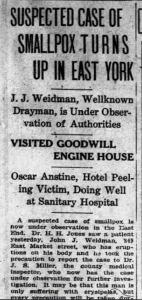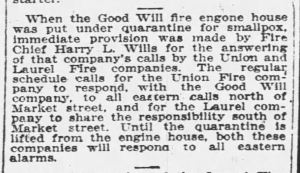The 1918 Smallpox Outbreak
In 1918, a smallpox outbreak struck York and York County. And the common location for most of the cases in York City was the Goodwill engine house.
 On March 19, 1918, John J. Weidman, of 849 East Market Street, was the second Smallpox patient identified. Weidman was a drayman, and had recently visited the drivers at the Goodwill. Albert Kauffman, the driver of the combination chemical and hose wagon at the Goodwill, who lived at the Weidman residence, was the third patient identified. The Goodwill was placed out of service, and the Union and the Laurel were instructed to pick up the Goodwill's alarm assignments.
On March 19, 1918, John J. Weidman, of 849 East Market Street, was the second Smallpox patient identified. Weidman was a drayman, and had recently visited the drivers at the Goodwill. Albert Kauffman, the driver of the combination chemical and hose wagon at the Goodwill, who lived at the Weidman residence, was the third patient identified. The Goodwill was placed out of service, and the Union and the Laurel were instructed to pick up the Goodwill's alarm assignments.
The men were quarantined in the Sanitary Hospital to help stop the spread of the disease. The Sanitary Hospital was built by the city in 1904-1905 on Kings Mill Road, near South Penn Street, next to the old garbage incinerator, as a hospital to isolate patients with highly contagious diseases. It was also referred to as the Municipal Hospital, and had the nickname of the "Pest House." A "Herculean effort" was made by city officials to get necessary work completed on the old hospital to put it back into use. Apparently the building had been left alone since the caretaker resigned and moved out in November of 1916. A number of windows had been broken out and the building's system needed restored to good working order.
The Weidman home was quarantined, and the Mayor and Health Board urged residents, especially those with contact with the infected or the Goodwill, to get vaccinated. This included members of the Fox Club, the Goodwill's social club located behind the engine house. Each person potentially exposed was required to be vaccinated, and to report to the physician who vaccinated them for 18 days.
 At the Goodwill, the engine house was fumigated and placarded against entry until lifted by the state health department. All the apparatus was washed with a strong solution of chemicals, and the blankets and bed clothing were ordered burned. Steamer Driver Henry J. Holland was quarantined at the Goodwill, and was assigned to care for the horses and apparatus. He was not allowed to leave the building, and was not allowed to have any visitors. He was quarantined at the engine house for 18 days.
At the Goodwill, the engine house was fumigated and placarded against entry until lifted by the state health department. All the apparatus was washed with a strong solution of chemicals, and the blankets and bed clothing were ordered burned. Steamer Driver Henry J. Holland was quarantined at the Goodwill, and was assigned to care for the horses and apparatus. He was not allowed to leave the building, and was not allowed to have any visitors. He was quarantined at the engine house for 18 days.
Guards were sworn in at City Hall and assigned to the Goodwill engine house to prevent anyone from entering or leaving, and guards were assigned to the Weidman house as well.
Just as the city thought it was done with Smallpox, Charles Elmer Zimmerman, of 931 East Market Street, was identified as having smallpox on April 1, 1918. It was presumed that he too contracted it from visiting the Goodwill engine house. Zimmermanís mother also washed Albert Kauffman's clothing, which provided another possibility for his exposure. Zimmerman had not been vaccinated as he said he had previously had smallpox, which ended up being incorrect. He too was quarantined at the Sanitary Hospital, remaining there until May 7, 1918.
The quarantine for the Goodwill engine house was lifted on April 1, 1918. The regularly scheduled Goodwill fire company meeting was not held on the evening of April 1, 1918 since the quarantine had just been lifted.
President Franklin Leader of the Goodwill took action forbidding the company from participating in a parade which was held in York on April 6, 1918. The Goodwill was the only city fire company not to participate in the parade.
Although the disease continued to pop up in northern York County, the Smallpox scare was over in the city, with only one additional case on April 7, 1918, with no apparent connection to the Goodwill.
Any additions, corrections and/or comments are welcomed.